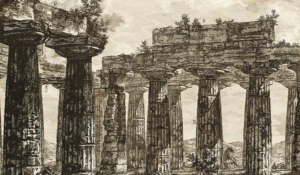A volume of etchings by Giovanni Battista Piranesi | Fine Interiors: 8th November 2022
From the volume of Piranesi etchings: detail of the pronaos or vestibule from one of the Greek temples at Paestum, from the full set of Différentes vues de quelques Restes de trois grands Edifices…dans le milieu de l’ancienne Ville de Pesto | From the library of Arthur Clarke Edwards (1859-1916)
Lot 62 from the recent auction of Fine Interiors was a volume of etchings, most of which are by Giovanni Battista Piranesi (1720-1778). The group includes Piranesi’s last great work, a full set of the Views of the Temples at Paestum – the importance of this ancient site was finally becoming recognised during the second half of the 18th century. At the time of his death in November 1778 Piranesi had received the papal imprimatur for the series, and three of the plates in the set were etched by Piranesi’s son, Francesco (1758-1810), who took on the running of his father’s business, initially in Rome and then later in Paris.
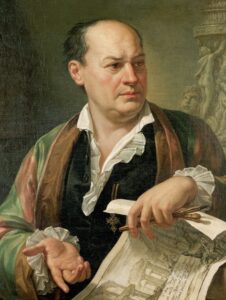
Pietro Labruzzi (1739-1805), Portrait of Giovanni Battista Piranesi, 1779, oil on canvas, thought to be created after the bust of Piranesi ascribed to Joseph Nollekens in the Accademia di San Luca, Rome
Piranesi was born in Venice, his father was a stonemason and as a youngster, through his brother, he was introduced to the history and aspects of ancient Greco-Roman civilisation. His uncle, Matteo Lucchesi (1705-1776) was Magistrate of Waterworks, an important role in the Ducal Republic with responsibility for engineering and the restoration of historic buildings, and Piranesi was apprenticed under him.
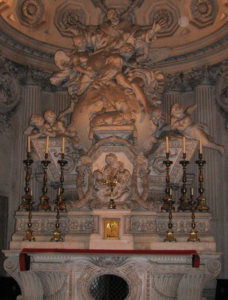
Piranesi’s altar at the Church of Santa Maria, Rome; he was appointed to undertake the restoration of the church, his only architectural work, by Cardinal Rezzonico, nephew of Pope Clement XIII | Image: Johannes Joas
Throughout his varied career he was happy to be known as an architect, but in truth Piranesi built very few buildings. He is closely associated with the Church of Santa Maria on the Aventine Hill, Rome, working on its restoration from 1746-66. Along with work on the exterior he restored the vault, decorated the interiors and created a highly decorative and sculptural main altar. Fittingly, Santa Maria is Piranesi’s final resting place.

From the volume of etchings: detail from Piranesi’s Altra Veduta del tempio della Sibilla in Tivoli
Piranesi produced many views in and around Rome, and the volume includes a number of his etchings of the city. He studied in Rome from 1740, working as a draughtsman for Marco Foscarini, the Venetian ambassador to Pope Benedict XIV. Under Giuseppe Vasi, the engraver and architect renowned for his vedute, Piranesi was introduced to the art of etching and engraving the city and its monuments. His main inspiration came from his close study of classical antiquities, as well as his knowledge of Renaissance and Baroque structures. After studying with Vasi, Piranesi collaborated with the students of the French Academy in Rome and a series of vedute were produced, the first Prima parte di Architetettura e Prospetitive, in 1743. Piranesi’s output of course amounts to so much more than the accurate capture of a topographical view, he had a well honed understanding of construction and combined this with an incredible imagination to present ancient buildings and their environs in a highly unique fashion – he used altered perspectives, exaggerated scale and contemporary human activity – demonstrating his appreciation of and deep empathy with historical Roman architecture.
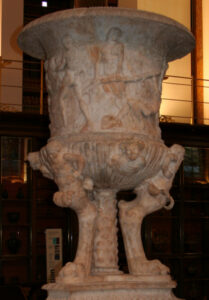
The Piranesi Vase, on display at the British Museum, London | Image: Steve F. E. Cameron
Piranesi’s series of Roman vedute established his name and fame, and he produced etchings on this theme until 1774. In 1769 he published unusual designs for chimneypieces, and for an original range of furniture. In 1776 he was known to be working on the Piranesi Vase – his most ambitious restoration project – as it was spotted as work in progress in his workshop. The piece was part reconstruction and part pastiche, and featured Roman fragments discovered at Hadrian’s Villa at Tivoli during excavation works undertaken in the 1770s. Unrelated ancient fragments were also employed, along with matching modern parts, its frieze depicts satyrs making wine for which original fragments were used. The vase was acquired by Sir John Boyd during his Grand Tour and was displayed in the grounds of his Neo-Palladian mansion, Danson House. With the Vase and his earlier creations Piranesi extended his repertoire and built a reputation as an adaptable, flexible designer.
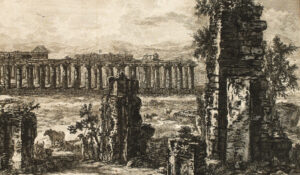
From the volume of etching: detail from Ville de Pesto appellée par les Grecs Possidonia…from the Paestum series of etchings
Piranesi published Avanzi degli Edifici di Pesto (Remains of the Edifices of Paestum) in 1777-8. The series of drawings recorded the three Greek Doric temples found on the site: the Basilica (later identified at the Temple of Hera), the Temple of Neptune and the Temple of Ceres. The Roman city of Paestum dated from 273 BC and continued to prosper during the Roman Imperial period, becoming a bishopric as the Roman Catholic Diocese of Pesto, around 400 AD. However, by the Middle Ages Paestum was largely abandoned and the site became overgrown and was mostly forgotten, although some re-purposed building stone (spoila) was used in Salerno Cathedral in the 11th century.
The ruins at Paestum only came to notice again in the 18th century following the re-discovery of Pompeii and Herculaneum, and the three temples generated massive interest throughout Europe. The first modern publication on the ruins, Les Ruines des Paestum, was produced in 1764 by G P M Dumont, ten years later nine different publications documenting Paestum had been published such was the intensity of its appeal and intrigue. Piranesi’s own etchings of Paestum were circulated widely to a curious audience. The complete, simple form of the ancient temples at Paestum was to influence early Greek Revival architecture.
.

